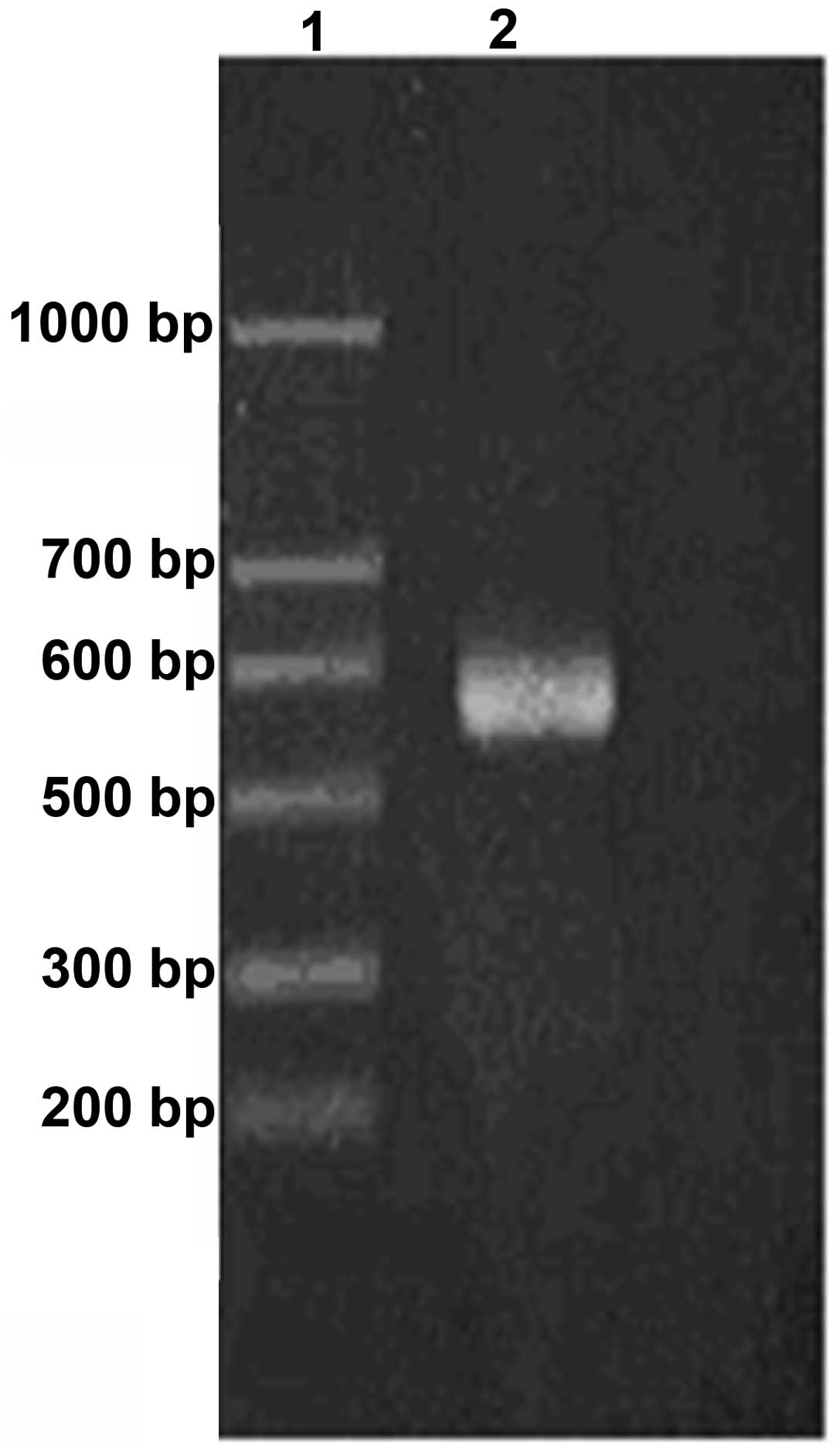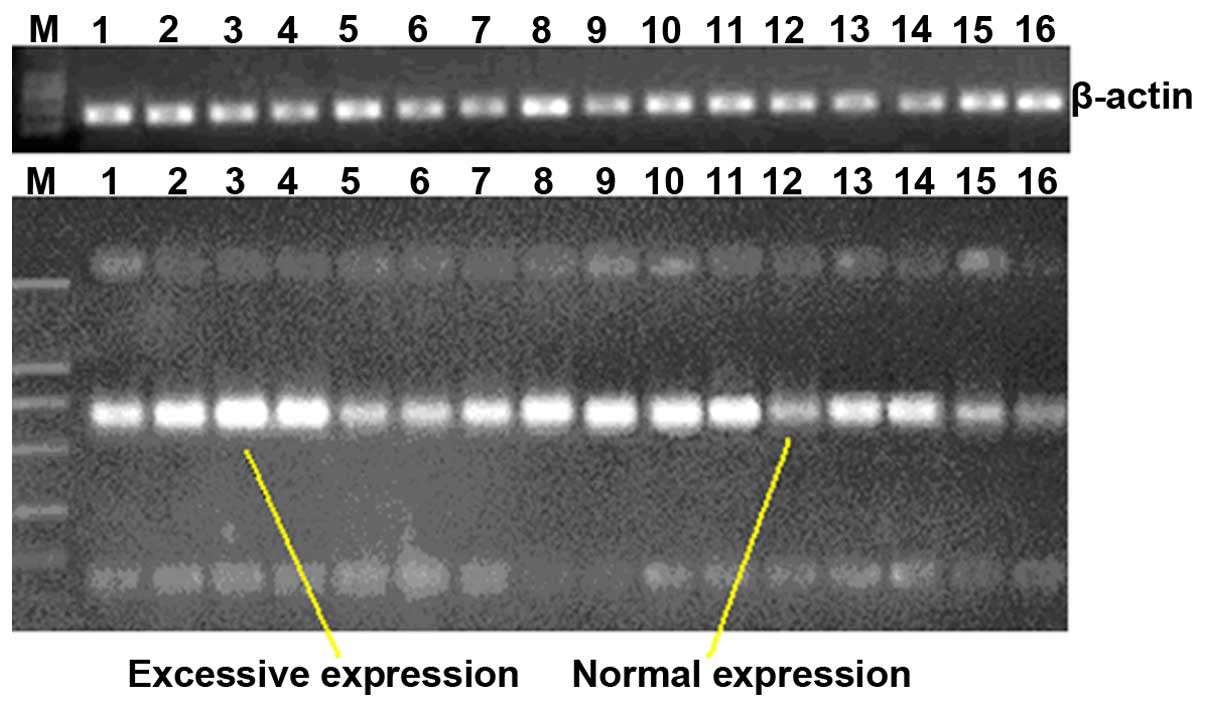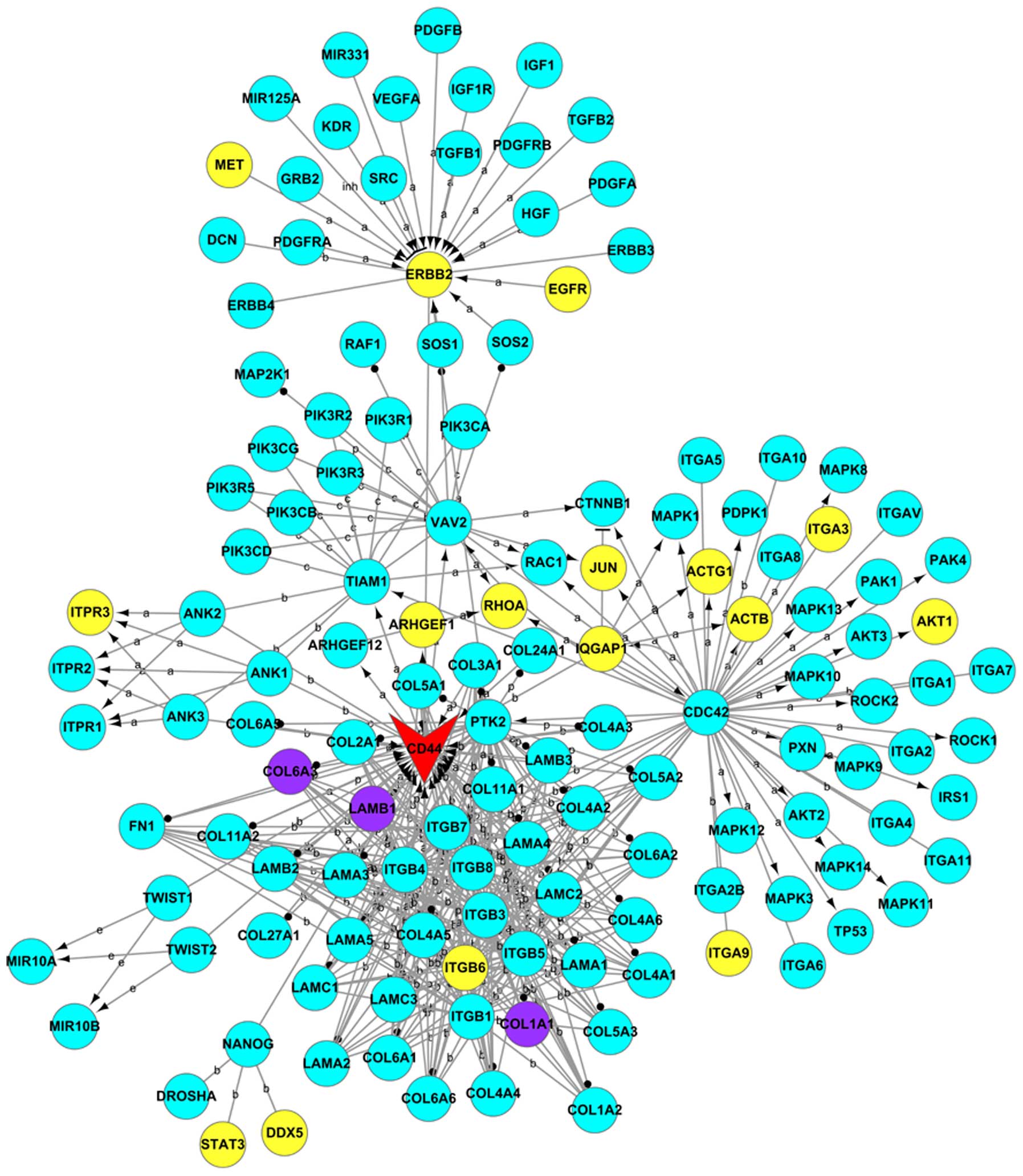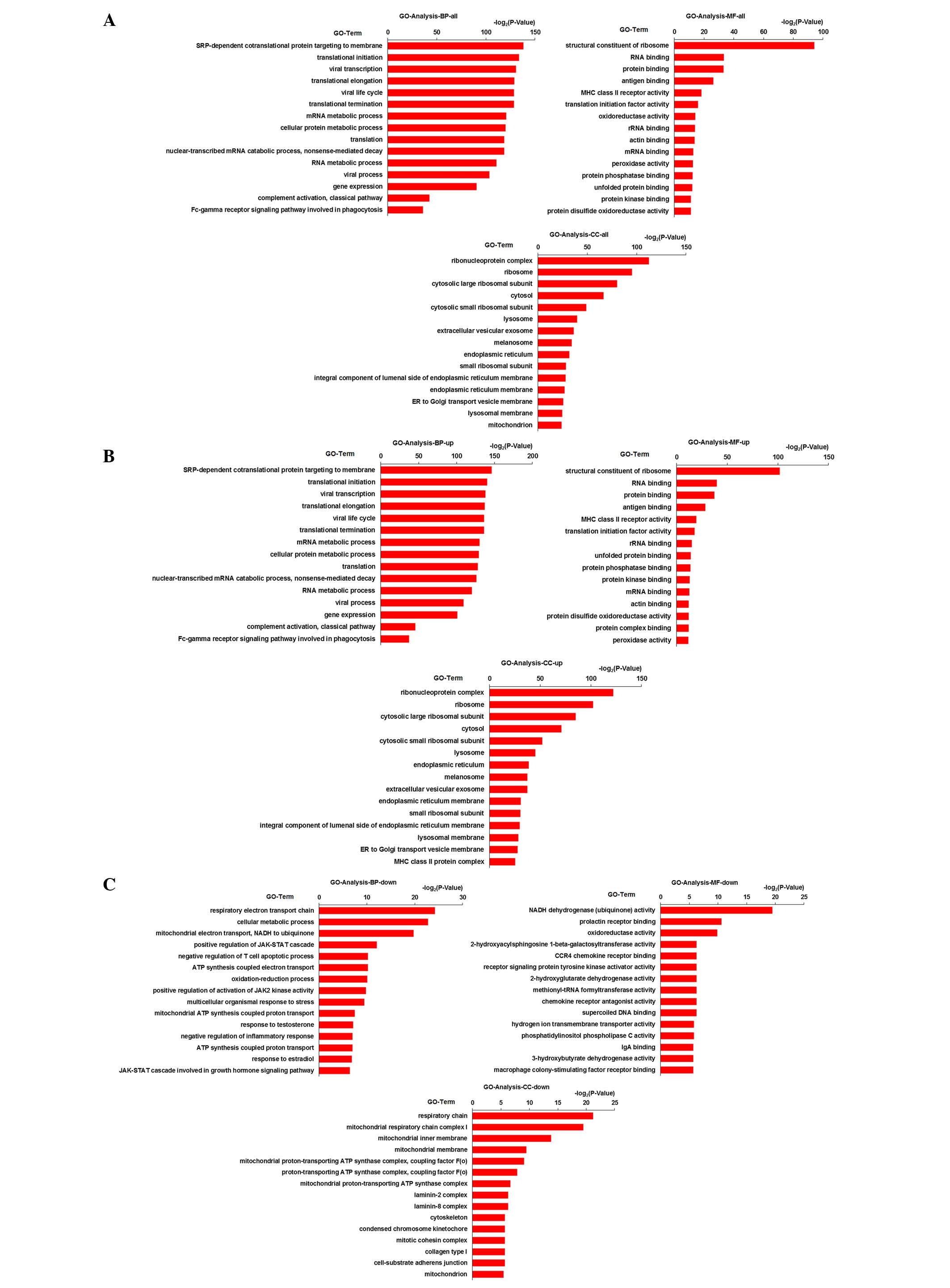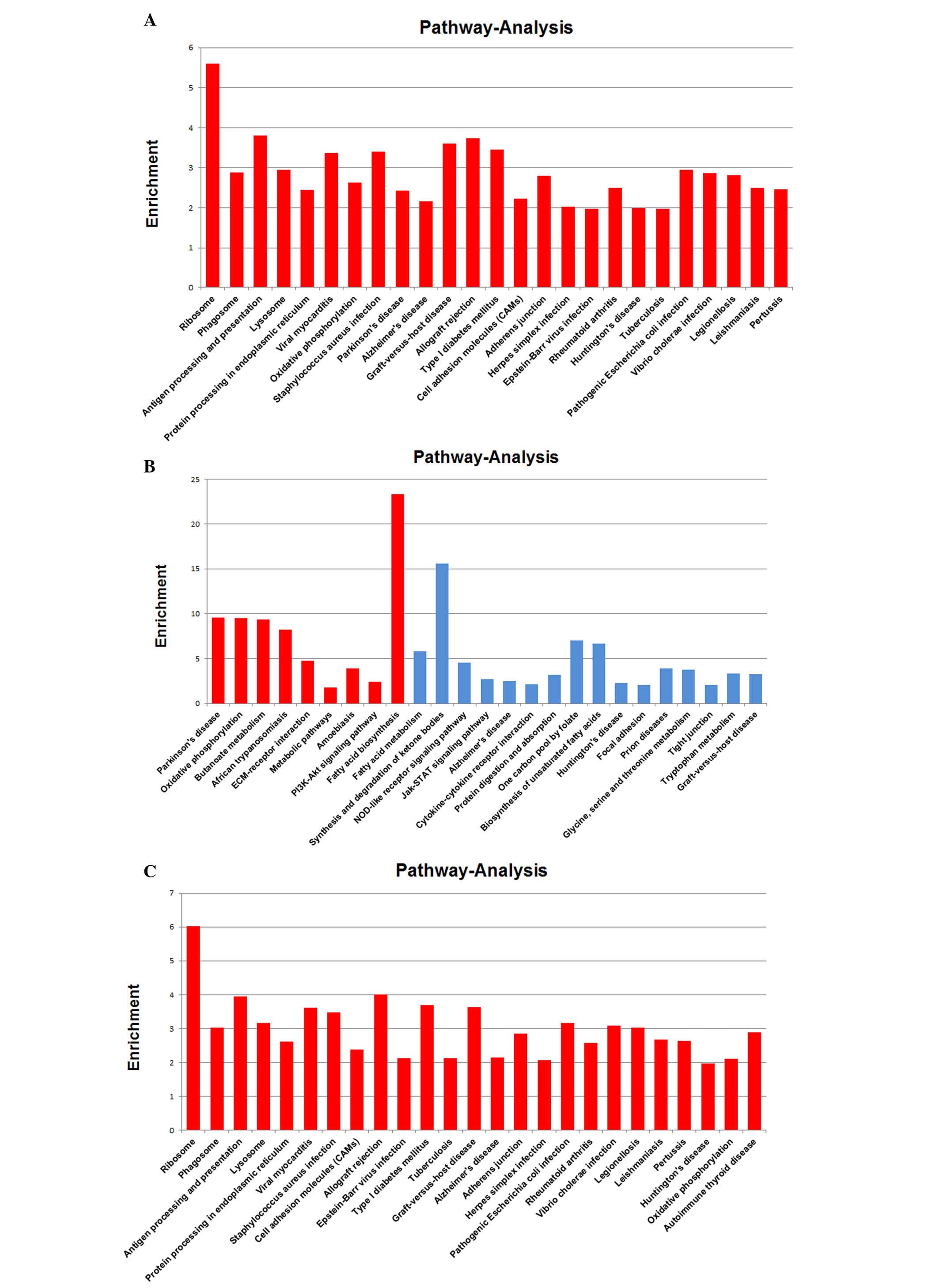|
1
|
Jemal A, Bray F, Center MM, Ferlay J, Ward
E and Forman D: Global cancer statistics. CA Cancer J Clin.
61:69–90. 2011. View Article : Google Scholar : PubMed/NCBI
|
|
2
|
Yang P, Allen MS, Aubry MC, Wampfler JA,
Marks RS, Edell ES, Thibodeau S, Adjei AA, Jett J and Deschamps C:
Clinical features of 5,628 primary lung cancer patients: Experience
at Mayo clinic from 1997 to 2003. Chest. 128:452–462. 2005.
View Article : Google Scholar : PubMed/NCBI
|
|
3
|
Pope CA III, Burnett RT, Thun MJ, Calle
EE, Krewski D, Ito K and Thurston GD: Lung cancer, cardiopulmonary
mortality, and long-term exposure to fine particulate air
pollution. JAMA. 287:1132–1141. 2002. View Article : Google Scholar : PubMed/NCBI
|
|
4
|
Thatcher N, Chang A, Parikh P, Rodrigues
Pereira J, Ciuleanu T, von Pawel J, Thongprasert S, Tan EH,
Pemberton K, Archer V and Carroll K: Gefitinib plus best supportive
care in previously treated patients with refractory advanced
non-small-cell lung cancer: Results from a randomised,
placebo-controlled, multicentre study (Iressa Survival Evaluation
in Lung Cancer). Lancet. 366:1527–1537. 2005. View Article : Google Scholar : PubMed/NCBI
|
|
5
|
Malvezzi M, Bertuccio P, Levi F, La Vecchi
C and Negri E: European cancer mortality predictions for the year
2012. Ann Oncol. mds024. 2012. View Article : Google Scholar : PubMed/NCBI
|
|
6
|
Graham MV, Purdy JA, Emami B, Harms W,
Bosch W, Lockett MA and Perez CA: Clinical dose-volume histogram
analysis for pneumonitis after 3D treatment for non-small cell lung
cancer (NSCLC). Int J Radiat Oncol Biol Phys. 45:323–329. 1999.
View Article : Google Scholar : PubMed/NCBI
|
|
7
|
Goldstraw P, Ball D, Jett JR, et al:
Non-small-cell lung cancer. The Lancet. 378:1727–1740. 2011.
View Article : Google Scholar
|
|
8
|
Früh M, Rolland E, Pignon JP, Seymour L,
Ding K, Tribodet H, Winton T, Le Chevalier T, Scagliotti GV,
Douillard JY, et al: Pooled analysis of the effect of age on
adjuvant cisplatin-based chemotherapy for completely resected
non-small-cell lung cancer. J Clin Oncol. 26:3573–3581. 2008.
View Article : Google Scholar : PubMed/NCBI
|
|
9
|
Shepherd F, Pereira J, Ciuleanu T, et al:
A randomized placebo-controlled trial of erlotinib in patients with
advanced non-small cell lung cancer (NSCLC) following failure of
1st line or 2nd line chemotherapy. A National Cancer Institute of
Canada Clinical Trials Group (NCIC CTG) trial. ASCO Annual Meeting
Proceedings. pp. 70222004
|
|
10
|
Yasuda M, Nakano K, Yasumoto K and Tanaka
Y: CD44: Functional relevance to inflammation and malignancy.
Histol Histopathol. 17:945–950. 2002.PubMed/NCBI
|
|
11
|
Mizera-Nyczak E, Dyszkiewicz W, Heider KH
and Zeromski J: Isoform expression of CD44 adhesion molecules,
Bcl-2, p53 and Ki-67 proteins in lung cancer. Tumour Biol.
22:45–53. 2001. View Article : Google Scholar
|
|
12
|
Situ D, Long H, Lin P, Zhu Z, Wang J,
Zhang X, Xie Z and Rong T: Expression and prognostic relevance of
CD44v6 in stage I non-small cell lung carcinoma. J Cancer Res Clin
Oncol. 136:1213–1219. 2010. View Article : Google Scholar : PubMed/NCBI
|
|
13
|
Aruffo A, Stamenkovic I, Melnick M,
Underhill CB and Seed B: CD44 is the principal cell surface
receptor for hyaluronate. cell. 61:1303–1313. 1990. View Article : Google Scholar : PubMed/NCBI
|
|
14
|
Weber GF, Ashkar S, Glimcher MJ and Cantor
H: Receptor-ligand interaction between CD44 and osteopontin
(Eta-1). Science. 271:509–512. 1996. View Article : Google Scholar : PubMed/NCBI
|
|
15
|
Miyoshi T, Kondo K, Hino N, Uyama T and
Monden Y: The expression of the CD44 variant exon 6 is associated
with lymph node metastasis in non-small cell lung cancer. Clin
Cancer Res. 3:1289–1297. 1997.PubMed/NCBI
|
|
16
|
Ariza A, Mate JL, Isamat M, López D, Von
Uexküll-Güldeband C, Rosell R, Fernández-Vasalo A and
Navas-Palacios JJ: Standard and variant CD44 isoforms are commonly
expressed in lung cancer of the non-small cell type but not of the
small cell type. J Pathol. 177:363–368. 1995. View Article : Google Scholar : PubMed/NCBI
|
|
17
|
Yasuda M, Tanaka Y, Fujii K and Yasumoto
K: CD44 stimulation down-regulates Fas expression and Fas-mediated
apoptosis of lung cancer cells. Int Immunol. 13:1309–1319. 2001.
View Article : Google Scholar : PubMed/NCBI
|
|
18
|
Takigawa N, Segawa Y, Mandai K, Takata I
and Fujimoto N: Serum CD44 levels in patients with non-small cell
lung cancer and their relationship with clinicopathological
features. Lung Cancer. 18:147–157. 1997. View Article : Google Scholar : PubMed/NCBI
|
|
19
|
Szpechcinski A, Rudzinski P, Kupis W,
Langfort R, Orlowski T and Chorostowska-Wynimko J: Plasma cell-free
DNA levels and integrity in patients with chest radiological
findings: NSCLC versus benign lung nodules. Cancer Lett.
374:202–207. 2016. View Article : Google Scholar : PubMed/NCBI
|
|
20
|
Livak KJ and Schmittgen TD: Analysis of
relative gene expression data using real-time quantitative PCR and
the 2 (−Delta Delta C(T)) method. Methods. 25:402–408. 2001.
View Article : Google Scholar
|
|
21
|
Shendure J and Ji H: Next-generation DNA
sequencing. Nat Biotechnol. 26:1135–1145. 2008. View Article : Google Scholar : PubMed/NCBI
|
|
22
|
Guldberg P, Romano V, Ceratto N, Bosco P,
Ciuna M, Indelicato A, Mollica F, Meli C, Giovannini M and Riva E:
Mutational spectrum of phenylalanine hydroxylase deficiency in
sicily: Implications for diagnosis of hyperphenylalaninemia in
southern Europe. Hum Mol Genet. 2:1703–1707. 1993. View Article : Google Scholar : PubMed/NCBI
|
|
23
|
Ashburner M, Ball CA, Blake JA, Botstein
D, Butler H, Cherry JM, Davis AP, Dolinski K, Dwight SS, Eppig JT,
et al: Gene ontology: Tool for the unification of biology. The Gene
Ontology Consortium. Nat Genet. 25:25–29. 2000. View Article : Google Scholar : PubMed/NCBI
|
|
24
|
Bauer S, Grossmann S, Vingron M and
Robinson PN: Ontologizer 2.0-a multifunctional tool for GO term
enrichment analysis and data exploration. Bioinformatics.
24:1650–1651. 2008. View Article : Google Scholar : PubMed/NCBI
|
|
25
|
Wang J: Functional Enrichment Analysis.
Encyclopedia of Systems Biology. Springer; pp. 772. 2013,
View Article : Google Scholar
|
|
26
|
Kanehisa M and Goto S: KEGG: Kyoto
encyclopedia of genes and genomes. Nucleic Acids Res. 28:27–30.
2000. View Article : Google Scholar
|
|
27
|
Hosack DA, Dennis G Jr, Sherman BT, Lane
HC and Lempicki RA: Identifying biological themes within lists of
genes with EASE. Genome Biol. 4:R702003. View Article : Google Scholar : PubMed/NCBI
|
|
28
|
Banerji S, Ni J, Wang SX, Clasper S, Su J,
Tammi R, Jones M and Jackson DG: LYVE-1, a new homologue of the
CD44 glycoprotein, is a lymph-specific receptor for hyaluronan. J
Cell Biol. 144:789–801. 1999. View Article : Google Scholar : PubMed/NCBI
|
|
29
|
De la Torre M, Heldin P and Bergh J:
Expression of the CD44 glycoprotein (lymphocyte-homing receptor) in
untreated human breast cancer and its relationship to prognostic
markers. Anticancer Res. 15:2791–2795. 1995.PubMed/NCBI
|
|
30
|
Kito H, Suzuki H, Ichikawa T, Sekita N,
Kamiya N, Akakura K, Igarashi T, Nakayama T, Watanabe M, Harigaya K
and Ito H: Hypermethylation of the CD44 gene is associated with
progression and metastasis of human prostate cancer. Prostate.
49:110–115. 2001. View Article : Google Scholar : PubMed/NCBI
|
|
31
|
Pinheiro C, Reis RM, Ricardo S,
Longatto-Filho A, Schmitt F and Baltazar F: Expression of
monocarboxylate transporters 1, 2, and 4 in human tumours and their
association with CD147 and CD44. J Biomed Biotechnol. 2010.
View Article : Google Scholar : PubMed/NCBI
|
|
32
|
Stamenkovic I, Amiot M, Pesando JM and
Seed B: A lymphocyte molecule implicated in lymph node homing is a
member of the cartilage link protein family. Cell. 56:1057–1062.
1989. View Article : Google Scholar : PubMed/NCBI
|
|
33
|
Dohadwala M, Batra RK, Luo J, Lin Y,
Krysan K, Pold M, Sharma S and Dubinett SM: Autocrine/paracrine
prostaglandin E2 production by non-small cell lung cancer cells
regulates matrix metalloproteinase-2 and CD44 in
cyclooxygenase-2-dependent invasion. J Biol Chem. 277:50828–50833.
2002. View Article : Google Scholar : PubMed/NCBI
|
|
34
|
Turke AB, Zejnullahu K, Wu YL, Song Y,
Dias-Santagata D, Lifshits E, Toschi L, Rogers A, Mok T, Sequist L,
et al: Preexistence and clonal selection of MET amplification in
EGFR mutant NSCLC. Cancer cell. 17:77–88. 2010. View Article : Google Scholar : PubMed/NCBI
|
|
35
|
Ou SH, Kwak EL, Siwak Tapp C, Dy J,
Bergethon K, Clark JW, Camidge DR, Solomon BJ, Maki RG, Bang YJ, et
al: Activity of crizotinib (PF02341066), a dual
mesenchymal-epithelial transition (MET) and anaplastic lymphoma
kinase (ALK) inhibitor, in a non-small cell lung cancer patient
with de novo MET amplification. J Thorac Oncol. 6:942–946. 2011.
View Article : Google Scholar : PubMed/NCBI
|
|
36
|
Cappuzzo F, Marchetti A, Skokan M, Rossi
E, Gajapathy S, Felicioni L, Del Grammastro M, Sciarrotta MG,
Buttitta F, Incarbone M, et al: Increased MET gene copy number
negatively affects survival of surgically resected non-small-cell
lung cancer patients. J Clin Oncol. 27:1667–1674. 2009. View Article : Google Scholar : PubMed/NCBI
|
|
37
|
Nakamura H, Saji H, Ogata A, Hosaka M,
Hagiwara M, Kawasaki N and Kato H: Correlation between encoded
protein overexpression and copy number of the HER2 gene with
survival in non-small cell lung cancer. Int J Cancer. 103:61–66.
2003. View Article : Google Scholar
|
|
38
|
Minami Y, Shimamura T, Shah K, LaFramboise
T, Glatt KA, Liniker E, Borgman CL, Haringsma HJ, Feng W, Weir BA,
et al: The major lung cancer-derived mutants of ERBB2 are oncogenic
and are associated with sensitivity to the irreversible EGFR/ERBB2
inhibitor HKI-272. Oncogene. 26:5023–5027. 2007. View Article : Google Scholar : PubMed/NCBI
|
|
39
|
Kristiansen G, Yu Y, Petersen S, Kaufmann
O, Schlüns K, Dietel M and Petersen I: Overexpression of c-erbB2
protein correlates with disease-stage and chromosomal gain at the
c-erbB2 locus in non-small cell lung cancer. Eur J Cancer.
37:1089–1095. 2001. View Article : Google Scholar : PubMed/NCBI
|
|
40
|
Cragg MS, Kuroda J, Puthalakath H, Huang
DC and Strasser A: Gefitinib-induced killing of NSCLC cell lines
expressing mutant EGFR requires BIM and can be enhanced by BH3
mimetics. PLoS Med. 4:1681–1689. 2007. View Article : Google Scholar : PubMed/NCBI
|
|
41
|
Kobayashi S, Boggon TJ, Dayaram T, Jänne
PA, Kocher O, Meyerson M, Johnson BE, Eck MJ, Tenen DG and Halmos
B: EGFR mutation and resistance of non-small-cell lung cancer to
gefitinib. N Engl J Med. 352:786–792. 2005. View Article : Google Scholar : PubMed/NCBI
|
|
42
|
Fukuoka M, Yano S, Giaccone G, Tamura T,
Nakagawa K, Douillard JY, Nishiwaki Y, Vansteenkiste J, Kudoh S,
Rischin D, et al: Multi-institutional randomized phase II trial of
gefitinib for previously treated patients with advanced
non-small-cell lung cancer (The IDEAL 1 Trial). J Clin Oncol.
21:2237–2246. 2003. View Article : Google Scholar : PubMed/NCBI
|
|
43
|
Tang JM, He QY, Guo RX and Chang XJ:
Phosphorylated Akt overexpression and loss of PTEN expression in
non-small cell lung cancer confers poor prognosis. Lung Cancer.
51:181–191. 2006. View Article : Google Scholar
|
|
44
|
Tsurutani J, Fukuoka J, Tsurutani H, Shih
JH, Hewitt SM, Travis WD, Jen J and Dennis PA: Evaluation of two
phosphorylation sites improves the prognostic significance of Akt
activation in non-small-cell lung cancer tumors. J Clin Oncol.
24:306–314. 2006. View Article : Google Scholar
|
|
45
|
Tsao AS, McDonnell T, Lam S, Putnam JB,
Bekele N, Hong WK and Kurie JM: Increased phospho-AKT (Ser473)
expression in bronchial dysplasia: Implications for lung cancer
prevention studies. Cancer Epidemiol Biomarkers Prev. 12:660–664.
2003.PubMed/NCBI
|
|
46
|
Nakamura H, Fujita K, Nakagawa H, Kishi F,
Takeuchi A, Aute I and Kato H: Expression pattern of the scaffold
protein IQGAP1 in lung cancer. Oncol Rep. 13:427–431.
2005.PubMed/NCBI
|
|
47
|
Lele L, Hailin P, Pei Q, et al: The
effect of down regulation of IQGAP1 on the biological behavior of
non-small cell lung cancer PC14/B
|
|
48
|
Gao J, McConnell MJ, Yu B, Li J, Balko JM,
Black EP, Johnson JO, Lloyd MC, Altiok S and Haura EB: MUC1 is a
downstream target of STAT3 and regulates lung cancer cell survival
and invasion. Int J Oncol. 35:337–345. 2009.PubMed/NCBI
|
|
49
|
Yin ZJ, Jin FG, Liu TG, Fu EQ, Xie YH and
Sun RL: Overexpression of STAT3 potentiates growth, survival and
radioresistance of non-small-cell lung cancer (NSCLC) cells. J Surg
Res. 171:675–683. 2011. View Article : Google Scholar
|
|
50
|
Jones FS and Jones PL: The tenascin family
of ECM glycoproteins: Structure, function and regulation during
embryonic development and tissue remodeling. Dev Dyn. 218:235–259.
2000. View Article : Google Scholar : PubMed/NCBI
|
|
51
|
Dmitriev AA, Kashuba VI, Haraldson K,
Senchenko VN, Pavlova TV, Kudryavtseva AV, Anedchenko EA, Krasnov
GS, Pronina IV, Loginov VI, et al: Genetic and epigenetic analysis
of non-small cell lung cancer with NotI-microarrays. Epigenetics.
7:502–513. 2012. View Article : Google Scholar : PubMed/NCBI
|
|
52
|
Anedchenko EA, Dmitriev AA, Krasnov GS,
Kondrat'eva TT, Kopantsev EP, Vinogradova TV, Zinov'eva MV,
Zborovskaia IB, Polotskiĭ BE, Sakharova OV, et al: Downregulation
of RBSP3/CTDSPL, NPRL2/G21, RASSF1A, ITGA9, HYAL1 and HYAL2 genes
in non-small cell lung cancer. Mol Biol (Mosk). 42:965–976. 2007.In
Russian.
|
|
53
|
Fan Z, LinLang G and XiangBin M: Analysis
of integrins differential expression in lung cancer cells. Cancer
Research on Prevention and Treatment. 36:734–736. 2009.
|
|
54
|
Hofmann HS, Bartling B, Simm A, Murray R,
Aziz N, Hansen G, Silber RE and Burdach S: Identification and
classification of differentially expressed genes in non-small cell
lung cancer by expression profiling on a global human
59.620-element oligonucleotide array. Oncol Rep. 16:587–595.
2006.PubMed/NCBI
|
|
55
|
Lu Y, Govindan R, Wang L, Liu PY, Goodgame
B, Wen W, Sezhiyan A, Pfeifer J, Li YF, Hua X, et al: MicroRNA
profiling and prediction of recurrence/relapse-free survival in
stage I lung cancer. Carcinogenesis. 33:1046–1054. 2012. View Article : Google Scholar : PubMed/NCBI
|
|
56
|
Kim YI, Lee A, Lee BH and Kim SY:
Prognostic significance of syndecan-1 expression in cervical
cancers. J Gynecol Oncol. 22:161–167. 2011. View Article : Google Scholar : PubMed/NCBI
|
|
57
|
Januchowski R, Zawierucha P, Ruciński M,
Nowicki M and Zabel M: Extracellular matrix proteins expression
profiling in chemoresistant variants of the A2780 ovarian cancer
cell line. Biomed Res Int. 3658672014.PubMed/NCBI
|
|
58
|
Anton ES, Hadjiargyrou M, Patterson PH and
Matthew WD: CD9 plays a role in Schwann cell migration in vitro. J
Neurosci. 15:584–595. 1995.PubMed/NCBI
|
|
59
|
Ono M, Handa K, Withers DA and Hakomori S:
Motility inhibition and apoptosis are induced by
metastasis-suppressing gene product CD82 and its analogue CD9, with
concurrent glycosylation. Cancer Res. 59:2335–2339. 1999.PubMed/NCBI
|
|
60
|
Zhu R, Xu R, Jiang X, Cai Y, Zou Y, Du M
and Qin L: Expression profile of cancer-related genes in human
adult bone marrow-derived neural stemlike cells highlights the need
for tumorigenicity study. J Neurosci Res. 85:3064–3070. 2007.
View Article : Google Scholar : PubMed/NCBI
|
|
61
|
Aravalli RN, Talbot NC and Steer CJ: Gene
expression profiling of MYC-driven tumor signatures in porcine
liver stem cells by transcriptome sequencing. World J
Gastroenterol. 21:2011–2029. 2015.PubMed/NCBI
|
|
62
|
Nwariaku F, Sikes P, Lightfoot E, McIntyre
K and Mileski WJ: Role of CD14 in hemorrhagic shock-induced
alterations of the monocyte tumor necrosis factor response to
endotoxin. J Trauma. 40:564–567. 1996. View Article : Google Scholar : PubMed/NCBI
|
|
63
|
Madjd Z, Durrant LG, Bradley R, Spendlove
I, Ellis IO and Pinder SE: Loss of CD55 is associated with
aggressive breast tumors. Clin Cancer Res. 10:2797–2803. 2004.
View Article : Google Scholar : PubMed/NCBI
|



